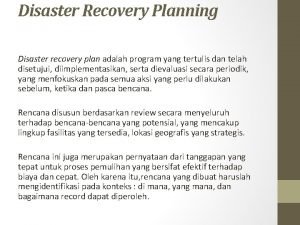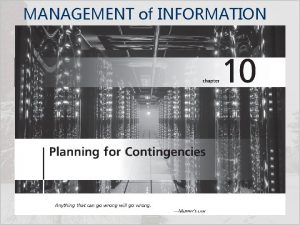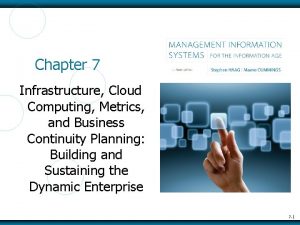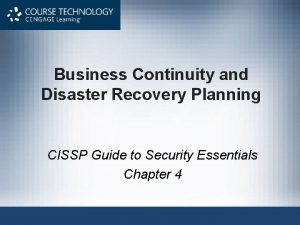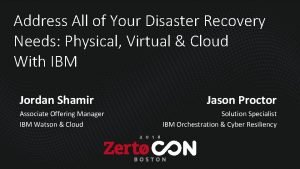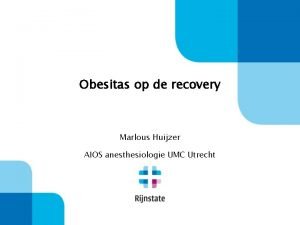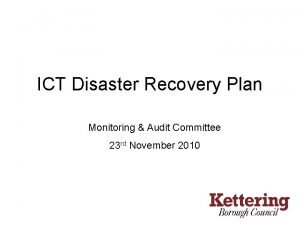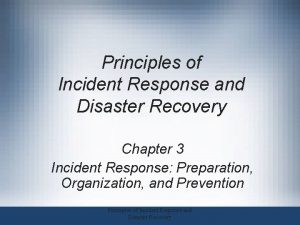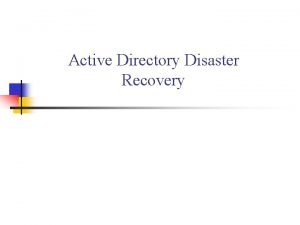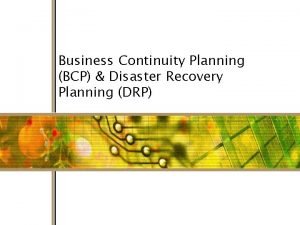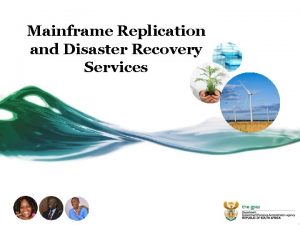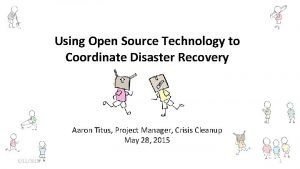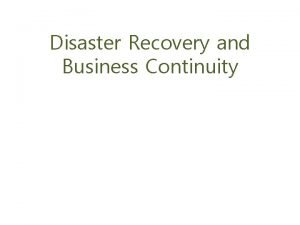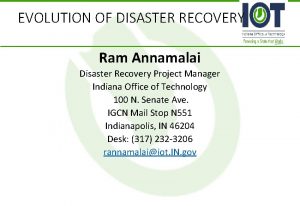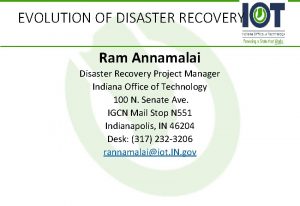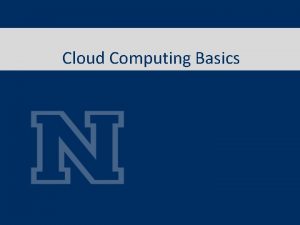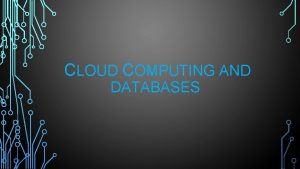Cloud Computing Disaster Recovery DR Dr Sanjay P























- Slides: 23

Cloud Computing Disaster Recovery (DR) Dr. Sanjay P. Ahuja, Ph. D. 2010 -14 FIS Distinguished Professor of Computer Science School of Computing, UNF

Need for Disaster Recovery (DR) What happens when you don’t have the right DR system!

What is DR? l Disaster recovery (DR) is about preparing for and recovering from a disaster. l Any event that has a negative impact on a company’s business continuity or finances could be termed a disaster. This includes hardware or software failure, a network outage, a power outage, physical damage to a building like fire or flooding, human error, or some other significant event. l According to AWS, “Disaster recovery is a continual process of analysis and improvement, as business and systems evolve. For each business service, customers need to establish an acceptable recovery point and time, and then build an appropriate DR solution. ” l DR on Cloud can significantly reduce costs (up to half the costs) as compared to a company maintaining it’s own redundant data centers. These costs include buying and maintaining servers and data centers, providing secure and stable connectivity and keeping them secure. The servers would also be under utilized.

Recovery Time Objective and Recovery Point Objective l Recovery time objective (RTO) — The time it takes after a disruption to restore a business process to its service level, as defined by the operational level agreement (OLA). For example, if a disaster occurs at 12: 00 PM (noon) and the RTO is eight hours, the DR process should restore the business process to the acceptable service level by 8: 00 PM. l Recovery point objective (RPO) — The acceptable amount of data loss measured in time. For example, if a disaster occurs at 12: 00 PM (noon) and the RPO is one hour, the system should recover all data that was in the system before 11: 00 AM. Data loss will span only one hour, between 11: 00 AM and 12: 00 PM (noon).

Recovery Time Objective and Recovery Point Objective l A company typically decides on an acceptable RTO and RPO based on the financial impact to the business when systems are unavailable. The company determines financial impact by considering many factors, such as the loss of business and damage to its reputation due to downtime and the lack of systems availability. l IT organizations then plan solutions to provide cost-effective system recovery based on the RPO within the timeline and the service level established by the RTO.

Traditional DR Practices l A traditional approach to DR involves different levels of off-site duplication of data and infrastructure. Critical business services are set up and maintained on this infrastructure and tested at regular intervals. The disaster recovery environment’s location and the source infrastructure should be a significant physical distance apart to ensure that the disaster recovery environment is isolated from faults that could impact the source site. l At a minimum, the infrastructure that is required to support the duplicate environment should include the following: 1. Facilities to house the infrastructure, including power and cooling. 2. Security to ensure the physical protection of assets. 3. Suitable capacity to scale the environment. 4. Support for repairing, replacing, and refreshing the infrastructure.

Traditional DR Practices 5. Contractual agreements with an Internet service provider (ISP) to provide Internet connectivity that can sustain bandwidth utilization for the environment under a full load. 6. Network infrastructure such as firewalls, routers, switches, and load balancers. 7. Enough server capacity to run all mission-critical services, including storage appliances for the supporting data, and servers to run applications and backend services such as user authentication, Domain Name System (DNS), Dynamic Host Configuration Protocol (DHCP), monitoring, and alerting.

Example Disaster Recovery Scenarios with AWS l l There are four DR scenarios that highlight the use of AWS. The following figure shows a spectrum for the four scenarios, arranged by how quickly a system can be available to users after a DR event.

Backup and Restore with AWS l To recover your data in the event of any disaster, you must first have your data periodically backed up from your system to AWS. Backing up of data can be done through various mechanisms and your choice will be based on the RPO (Recovery Point Objective). l For example, if you have a frequently changing database like say a stock market, then you will need a very high RPO. However if your data is mostly static with a low frequency of changes, you can opt for periodic incremental backup.

Data Backup Options to Amazon S 3 l The following figure shows data backup options to Amazon S 3, from either on -site infrastructure or from AWS.

Restoring a system from Amazon S 3 backups to Amazon EC 2 l The following diagram shows how to quickly restore a system from Amazon S 3 backups to Amazon EC 2.

Pilot Light for Quick Recovery into AWS l The term pilot light is often used to describe a DR scenario in which a minimal version of an environment is always running in the cloud. The idea of the pilot light is an analogy that comes from the gas heater. In a gas heater, a small flame that’s always on can quickly ignite the entire furnace to heat up a house. l With AWS you can maintain a pilot light by configuring and running the most critical core elements of your system in AWS. When the time comes for recovery, you can rapidly provision a full-scale production environment around the critical core. l Infrastructure elements for the pilot light itself typically includes database servers, which would replicate data to Amazon EC 2 or Amazon RDS. This is the critical core of the system (the pilot light) around which all other infrastructure pieces in AWS (the rest of the furnace) can quickly be provisioned to restore the complete system.

Pilot Light for Quick Recovery into AWS l To provision the remainder of the infrastructure to restore business-critical services, there would be some pre-configured servers bundled as Amazon Machine Images (AMIs), which are ready to be started up at a moment’s notice (this is the furnace in the analogy). When starting recovery, instances from these AMIs come up quickly with their pre-defined role (for example, Web or App Server) within the deployment around the pilot light. l If the on premise system fails, then the application and caching servers get activated; further users are rerouted using elastic IP addresses (which can be pre-allocated and identified in the preparation phase for DR) which can be associated to the new instances in the ad-hoc environment on cloud. Recovery takes just a few minutes. l The other option is to use Elastic Load Balancer (ELB) which automatically distributes incoming application traffic across multiple Amazon EC 2 instances. It provides even greater fault tolerance for applications by seamlessly providing the load-balancing capacity that is needed in response to incoming application traffic. The load balancer can be pre-allocated so that its DNS name is already known and the customer DNS tables point to the load balancer.

Pilot Light – Preparation Phase l The following figure shows the preparation phase, in which regularly changing data is replicated to the pilot light, the small core around which the full environment will be started in the recovery phase. Less frequently updated data, such as operating systems and applications, can be periodically updated and stored as AMIs.

Pilot Light – Recovery Phase l To recover the remainder of the environment around the pilot light, you can start your systems from the AMIs within minutes on the appropriate instance types. For your dynamic data servers, you can resize them to handle production volumes as needed or add capacity accordingly. Horizontal scaling often is the most cost-effective and scalable approach to add capacity to a system. For example, you can add more web servers at peak times. However, you can also choose larger Amazon EC 2 instance types, and thus scale vertically for applications such as relational databases. From a networking perspective, any required DNS updates can be done in parallel.

Warm Standby Solution in AWS l This technique is the next level of the pilot light, reducing recovery time to almost zero. The term warm standby is used to describe a DR scenario in which a scaled-down version of a fully functional environment is always running in the cloud. A warm standby solution extends the pilot light elements and preparation. It further decreases the recovery time because some services are always running. By identifying business-critical systems, a customer can fully duplicate these systems on AWS and have them always on. l These servers (app and caching servers) can be running on a minimum-sized fleet of Amazon EC 2 instances on the smallest sizes possible. This solution is not scaled to take a full-production load, but it is fully functional. It can be used for non-production work, such as testing, quality assurance, and internal use. l In a disaster, the system is scaled up quickly to handle the production load. In AWS, this can be done by adding more instances to the load balancer and by resizing the small capacity servers to run on larger Amazon EC 2 instance types. As stated in the preceding section, horizontal scaling is preferred over vertical scaling.

Warm Standby – Preparation Phase l The following figure shows the preparation phase for a warm standby solution, in which an on-site solution and an AWS solution run side-by-side.

Warm Standby – Recovery Phase l In the case of failure of the production system, the standby environment will be scaled up for production load, and DNS records will be changed to route all traffic to AWS as shown below.

Multi-Site Solution Deployed on AWS and On-Site l This is the optimum technique in backup and DR and is the next step after warm standby. A multi-site solution runs in AWS as well as on your existing on-site infrastructure, in an active-active (or hot-hot) configuration. l All activities in the preparatory stage are similar to a warm standby; except that the AWS backup on the cloud is also used to handle some portions of the user traffic using Route 53, a DNS service that supports weighted routing. l When a disaster strikes, the rest of the traffic that was pointing to the on premise servers are rerouted to AWS and using auto scaling techniques multiple EC 2 instances are deployed to handle full production capacity. You can further increase the availability of your multi-site solution by using multi. AZ’s (Availability Zones). l In AWS, Availability Zones within a region are well connected, but physically separated. For example, when deployed in Multi-AZ mode, Amazon RDS uses synchronous replication (data is atomically updated in multiple locations) to duplicate data in a second Availability Zone. This ensures that data is not lost if the primary Availability Zone becomes unavailable.

Multi-Site Solution – Preparation Phase l The following figure shows the use of weighted routing policy of the Amazon Route 53 DNS to route a portion of the traffic to the AWS site. The application on AWS might access data sources in the on-site production system. Data is replicated or mirrored to the AWS infrastructure.

Multi-Site Solution – Recovery Phase l The following figure shows the change in traffic routing in the event of an onsite disaster. Traffic is cut over to the AWS infrastructure by updating DNS, and all traffic and supporting data queries are supported by the AWS infrastructure.

Replication of Data l l l When data is replicated to a remote location, these factors need to considered: Distance between the sites — Larger distances typically are subject to more latency or jitter. Available bandwidth Data rate required by your application — The data rate should be lower than the available bandwidth. There are two main approaches for replicating data: synchronous and asynchronous.

Replication of Data Synchronous replication Data is atomically updated in multiple locations. This puts a dependency on network performance and availability. In AWS, Availability Zones within a region are well connected, but physically separated. For example, when deployed in Multi-AZ mode, Amazon RDS uses synchronous replication to duplicate data in a second Availability Zone. This ensures that data is not lost if the primary Availability Zone becomes unavailable. l Asynchronous replication Data is not atomically updated in multiple locations. It is transferred as network performance and availability allows, and the application continues to write data that might not be fully replicated yet. l l Many database systems support asynchronous data replication. The database replica can be located remotely, and the replica does not have to be completely synchronized with the primary database server. This is acceptable in many scenarios, for example, as a backup source or reporting/read-only use cases. In addition to database systems, this can also be extended to network file systems and data volumes.
 Snap cloud
Snap cloud A composable component must be modular
A composable component must be modular Disaster recovery plan adalah
Disaster recovery plan adalah Disaster recovery plan template nist
Disaster recovery plan template nist Disaster recovery cost curve
Disaster recovery cost curve Cissp business continuity and disaster recovery planning
Cissp business continuity and disaster recovery planning Sql server high availability and disaster recovery
Sql server high availability and disaster recovery Manufacturing disaster recovery
Manufacturing disaster recovery Hot site cold site warm site disaster recovery
Hot site cold site warm site disaster recovery Ibm vmware zerto disaster recovery
Ibm vmware zerto disaster recovery Pickwick syndroom
Pickwick syndroom Ict disaster recovery plan
Ict disaster recovery plan Emc business continuity
Emc business continuity Coop disaster recovery
Coop disaster recovery School disaster recovery plan
School disaster recovery plan Principles of incident response and disaster recovery
Principles of incident response and disaster recovery Disaster recovery audit program isaca
Disaster recovery audit program isaca International recovery platform
International recovery platform Disaster recovery plan adalah
Disaster recovery plan adalah Ad disaster recovery planning scenario
Ad disaster recovery planning scenario Bia drp
Bia drp Mainframe disaster recovery
Mainframe disaster recovery Open source disaster recovery
Open source disaster recovery Disaster recovery for dummies
Disaster recovery for dummies


